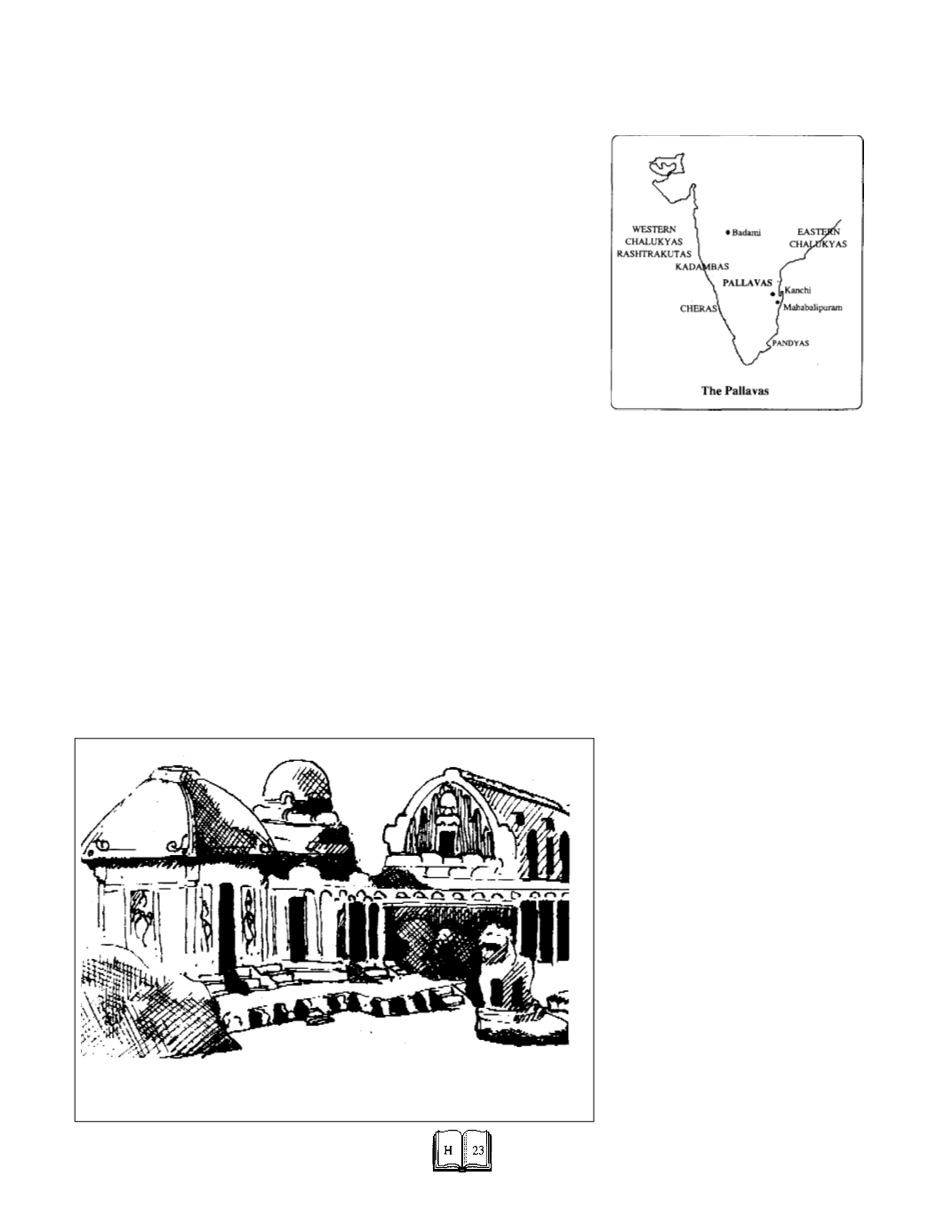

Eternal India
encyclopedia
LURE - THRU THE AGES
THE PALLAVAS 575 - 800 A.D.
Overview
The Pallavas patronized learning art, and
temple building (both cave temples and oth-
ers) including the temples and carvings at Ma-
habalipuram on the south coast of Madras.
Chronology
*
Simhavishnu Avanisimha
*
Mahendravarman I
*
Narasi mhavarman I
*
Mahendravarman II
*
Paramesvaravarman I
*
Narasimhavarman II
*
Nandivarman II
(575-600)
(600-630)
(c.630-668)
(668-670)
(670-695)
(695-722)
(730-800)
Simhavishnu Avanisimha 575-600
A.D.
Ascended the throne by about
575
A.D. It
was in his reign that the Pallavas started on
their career of political and cultural achieve-
ments. He is credited with the conquest of
Cholamandalam. He also defeated a number
of enemies including the Kalabhras. He was a
patron of Bharavi. At Mahabalipuram are found
the relics of Simhavishnu and his queens. He
is also stated to have defeated the kings of
Ceylon and three Tamil states.
Mahendravarman I 600-630
A.D.
Simhavishnu was succeeded by his son,
Mahendravarman, who was a Jain but later on
became a follower of Siva. He was a great
builder and he excavated many rock-cut
temples in Trichinopoly. He also built temples
in honour of Brahma, Isvara and Vishnu.
Mahendravarman was not only a patron of art
but also the author of a book on music. He had
a passion for titles and some of those titles
were
Chetthakari
(Temple
builder),
Chirtrakarapuli
(tiger among the painters),
Matavilasa
(addicted to enjoyment) and Vichi-
trachitta (myriad-minded).
Narasimhavarman I 630-668
A.D.
Mahendravarman was succeeded by his
son, Narasimhavarman I. He was the greatest
of the Pallava rulers. He defeated Pulakesin II
in three battles. He was successful in cap-
turing Vatapi, the capital of Pulakesin II, and
killed him. Narasimhavarman continued to
occupy the southern part of the Chalukya
kingdom.He assumed titles of
Mahamalla
and
Vatapikonda
or captor of Vatapi.
Narasimha I also sent a naval expedition to
Ceylon and was completely successful in his
mission. His achievements were so great that
he became supreme in the whole of south
India. Narasimha built a sea beach town near
Kanchi and gave it the name of Mamallapu-
ram (Mahabalipuram). There are a large
number of monolithic temples in that town.
Mahendravarman II 668-670
A.D.
Narasimhavarman was succeeded by his
son Mahendravarman II. He ruled for 2 years.
Paramesvaravarman 1670-695
A.D.
Mahendravarman II was succeeded by his
son Paramesvaravarman I. He was a follower
Rathas - Mahabalipuram
of Siva. He built a temple near Kanchi dedi-
cated to that god. During his reign the Cha-
lukyas under Vikramaditya I captured Kanchi.
Narasimhavarman II
695-722 A.D.
Paramesvaravarman I was succeeded by
his son Narasimhavarman II. He had a peace-
ful reign, he built the Kailasanatha temple at
Kanchi. Dandin, the great Sanskrit writer was
a court poet. Narasimhavarman sent an emis-
sary to China. He took up the titles of
Ra-
jasimha
(Lion among kings),
Agamapriya
(Lover of sculptures) and
Sankara bhakta
(devotee of Siva).
Nandivarman II
730-800 A.D.
He was the next important ruler of the
Pallava dynasty. During his reign, the old dis-
pute with the Chalukyas started once again.
Vikramaditya II captured Kanchi but the same
was recovered by the Pallavas. He was cred-
ited with the conquest of eastern Chalukya ter-
ritory. Dantidurga, the Rashtrakuta king, was
able to capture Kanchi, but he ultimately mar-
ried his daughter to Nandivarman. Nandivar-
man was a follower of Vishnu, during his reign
he built the Muktesvara temple at Kanchi; he
also performed an Ashvamedha sacrifice.
Decline
The Pallavas continued to rule till the end
of the 9th century. Later they were over-
thrown by the Rashtrakutas of Malkhed. There
was an internecine war between two later
Pallava rulers, Nripatunga and Aparajita. The
real gain from this civil war went to the Cho-
las, who succeeded them by about the begin-
ning of the 10th century (K. A. Nilakanta
Sastri).
















